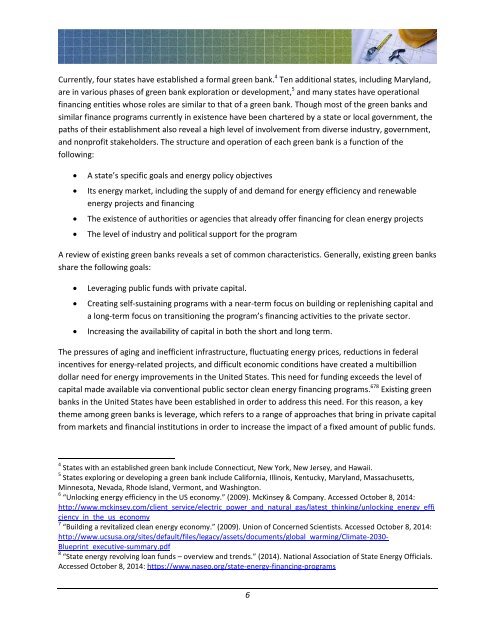bg4kk_f
bg4kk_f
bg4kk_f
Create successful ePaper yourself
Turn your PDF publications into a flip-book with our unique Google optimized e-Paper software.
Currently, four states have established a formal green bank. 4 Ten additional states, including Maryland,<br />
are in various phases of green bank exploration or development, 5 and many states have operational<br />
financing entities whose roles are similar to that of a green bank. Though most of the green banks and<br />
similar finance programs currently in existence have been chartered by a state or local government, the<br />
paths of their establishment also reveal a high level of involvement from diverse industry, government,<br />
and nonprofit stakeholders. The structure and operation of each green bank is a function of the<br />
following:<br />
<br />
<br />
<br />
<br />
A state’s specific goals and energy policy objectives<br />
Its energy market, including the supply of and demand for energy efficiency and renewable<br />
energy projects and financing<br />
The existence of authorities or agencies that already offer financing for clean energy projects<br />
The level of industry and political support for the program<br />
A review of existing green banks reveals a set of common characteristics. Generally, existing green banks<br />
share the following goals:<br />
<br />
<br />
<br />
Leveraging public funds with private capital.<br />
Creating self-sustaining programs with a near-term focus on building or replenishing capital and<br />
a long-term focus on transitioning the program’s financing activities to the private sector.<br />
Increasing the availability of capital in both the short and long term.<br />
The pressures of aging and inefficient infrastructure, fluctuating energy prices, reductions in federal<br />
incentives for energy-related projects, and difficult economic conditions have created a multibillion<br />
dollar need for energy improvements in the United States. This need for funding exceeds the level of<br />
capital made available via conventional public sector clean energy financing programs. 678 Existing green<br />
banks in the United States have been established in order to address this need. For this reason, a key<br />
theme among green banks is leverage, which refers to a range of approaches that bring in private capital<br />
from markets and financial institutions in order to increase the impact of a fixed amount of public funds.<br />
4 States with an established green bank include Connecticut, New York, New Jersey, and Hawaii.<br />
5 States exploring or developing a green bank include California, Illinois, Kentucky, Maryland, Massachusetts,<br />
Minnesota, Nevada, Rhode Island, Vermont, and Washington.<br />
6 “Unlocking energy efficiency in the US economy.” (2009). McKinsey & Company. Accessed October 8, 2014:<br />
http://www.mckinsey.com/client_service/electric_power_and_natural_gas/latest_thinking/unlocking_energy_effi<br />
ciency_in_the_us_economy<br />
7 “Building a revitalized clean energy economy.” (2009). Union of Concerned Scientists. Accessed October 8, 2014:<br />
http://www.ucsusa.org/sites/default/files/legacy/assets/documents/global_warming/Climate-2030-<br />
Blueprint_executive-summary.pdf<br />
8 “State energy revolving loan funds – overview and trends.” (2014). National Association of State Energy Officials.<br />
Accessed October 8, 2014: https://www.naseo.org/state-energy-financing-programs<br />
6


